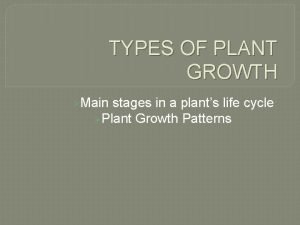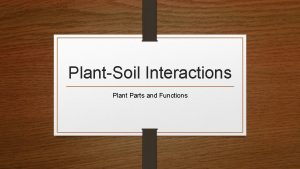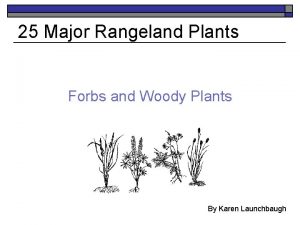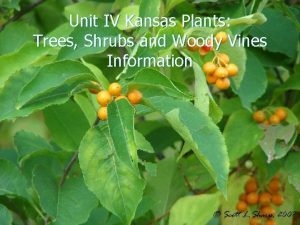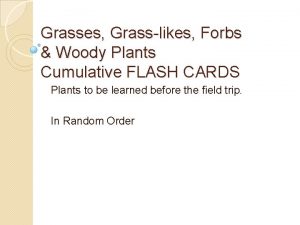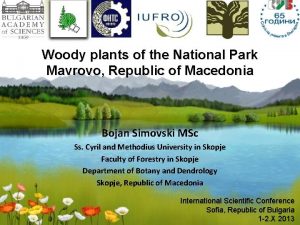Woody Plants Plants that live several years and


















- Slides: 18

Woody Plants - Plants that live several years and develop a large amount of wood in their stems.

Hebaceous Plants - Non-woody plants

Vine - any plant with a long, thin stem that grows along the ground or has tendrils that twine around a wall or other support. Vines can either be woody or herbaceous.

Taproot System – The primary (main) root grows straight down and remains larger than the secondary rootlets. This root system is in dicots.

Fibrous Root System – The primary root remains small and many slender secondary rootlets grow from it in all directions. This root system is in monocots.

Vegetative Reproduction - Plant reproduction without flowers, seeds, or fruits. This is done by roots, stems, and leaves capable of producing new plants.

Root Cap – tip of the root that is made up of several layers of dead cells and new growth cells that form immediately behind the cap. Protects the new plant cells as they push through the soil to lengthen the root.

Cambium - layer of cells in a woody dicot plant between its transport tubes that carry on cell division and make it possible for the root to grow in diameter.

Primary Growth - Growth in Length.

Secondary Growth - Growth in Diameter.

Root Hairs – Develop from the sides of the root and force their way between the soil particles to absorb water and dissolved minerals. Do this through the process of osmosis.

Osmosis – The movement of water from a solution of higher water content through a semipermeable membrane into a solution of lower water content.

Semipermeable Membrane – A membrane that will allow some molecules to pass through it but not others.

Cortex - Inner portion of the root consisting of storage cells surrounding the root’s transport system.

Xylem – Carries water and nutrients from the root hairs upward through the root and stem to the leaves. This is when photosynthesis will occur.

Root Pressure – The upward force that results as water enters the roots by osmosis.

Capillary Action – The tendency of the water molecules to move up through the xylem tissue in response to surface tension.

Transpiration – Evaporation from the leaves. In order for plants to replace this water they pull water to themselves.
 Four score and twenty
Four score and twenty Newton meets buzz and woody
Newton meets buzz and woody Ngoại tâm thu thất chùm đôi
Ngoại tâm thu thất chùm đôi Block xoang nhĩ độ 2 type 1
Block xoang nhĩ độ 2 type 1 Thơ thất ngôn tứ tuyệt đường luật
Thơ thất ngôn tứ tuyệt đường luật Thơ thất ngôn tứ tuyệt đường luật
Thơ thất ngôn tứ tuyệt đường luật Chiến lược kinh doanh quốc tế của walmart
Chiến lược kinh doanh quốc tế của walmart Tìm độ lớn thật của tam giác abc
Tìm độ lớn thật của tam giác abc Con hãy đưa tay khi thấy người vấp ngã
Con hãy đưa tay khi thấy người vấp ngã Tôn thất thuyết là ai
Tôn thất thuyết là ai Gây tê cơ vuông thắt lưng
Gây tê cơ vuông thắt lưng Sau thất bại ở hồ điển triệt
Sau thất bại ở hồ điển triệt Sheep years to human years
Sheep years to human years 300 solar years to lunar years
300 solar years to lunar years Woody vs herbaceous
Woody vs herbaceous Woody vs herbaceous
Woody vs herbaceous Ernestine woody-bethune
Ernestine woody-bethune Kacie woody
Kacie woody Stan woody
Stan woody














